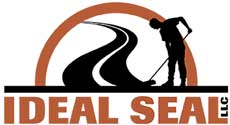 Let’s face it, nothing lasts forever – and that includes asphalt pavement. But that doesn’t mean you can’t extend the life of your asphalt parking lot (and improve its life-cycle cost) with timely repair and maintenance – and that includes sealcoating.
Let’s face it, nothing lasts forever – and that includes asphalt pavement. But that doesn’t mean you can’t extend the life of your asphalt parking lot (and improve its life-cycle cost) with timely repair and maintenance – and that includes sealcoating.
Understanding the nature of asphalt pavement, which coats the aggregate in the pavement, is important to understanding the impact pavement sealers can have on the life of your parking lot. Asphalt is a by-product of the oil refining process. The oil-based product had good waterproofing characteristics, it’s flexible, and it holds the aggregate together well.
Hot mix asphalt pavement also protects the aggregate base and clay or dirt subbase beneath it from getting wet. Because wet soil weakens the asphalt pavement layer, and when water finds its way beneath it, it causes potholes, extensive cracking, and additional damage that requires costly repairs.
Asphalt is not perfect. As it ages it decays – from sun, air, weather, and traffic – and breaks down. The first sign of this is that the black color becomes grey, then “hairline” cracks appear.
Sealcoating may help prevent this from happening. And compared to other pavement maintenance options such as cracksealing, remove-and-replace repairs, and asphalt overlays, sealcoating is the easiest and least-disruptive way to protect your pavement.
So, what, specifically, does sealcoating do?
1. Prevents water intrusion beneath the surface.
Because many sealers contain fine aggregate (usually silica sand or Black Beauty boiler slag), sealcoating fills the hairline cracks that are an early sign of asphalt aging. Water is more likely to find its way beneath the asphalt pavement surface if you fill cracks, and the longer you can keep it out, the longer your pavement will last.
2. Slows deterioration from oxidation.
Although you cannot prevent oxidation, timely sealcoating slows down its progression. Oxidation causes the pavement to become brittle and prone to cracks and allows other deterioration to occur. By applying sealer to the pavement surface, the asphalt binder becomes protected from the effects of air and sun. Regular application – usually every two to three years, dependent on traffic flow and region – will greatly extend the life of the pavement.
3. Protects the asphalt binder from oils and gasoline.
A leak of anything petroleum-based will almost essentially “join” with the binder, softening the asphalt. (If you’ve seen the black spots near the parking blocks in parking garages – oil spots – you know the damage leaks can cause). If your parking lot contains any of those black oil spots, they must be repaired prior to sealcoating. Failure to do so means sealer will have no effect on those spots and any damage to the pavement will continue to spread.
4. Enhances skid-resistance.
Applying sealer containing sand or boiler slag can help hold those fines in place but replenish them on the surface, providing more traction.
5. Enhances flexibility.
Asphalt pavement is a flexible surface as opposed to concrete pavement, which is rigid. When cars and trucks drive over asphalt pavement, it flexes under their weight (microscopically). By applying sealer on a regular basis, roadways retain their flexibility and slow the brittleness process of the pavement.
6. Enables easier pavement cleaning.
It’s less of a benefit to the physical pavement than you think. To prove it, sweep your concrete sidewalk with a push broom and then sweep the section of sealed pavement. Where the concrete tugs, the sealed pavement slides.
7. Extends pavement life.
Having all these things done to a pavement extends pavement life. A well-constructed asphalt pavement can last longer than 15 years when properly maintained. Sealcoating is an essential part of that maintenance process.
8. Saves you money!
Parking lots are one of the most costly investments on the property, so anything you can do to extend their life (thereby reducing their lifecycle costs) will help you get more bang for your buck. It has been determined that over a 15-year period, a properly maintained 10,000-square-foot parking lot can save a property manager over $120,000 when compared to the same lot that is not maintained.
Sealcoating has one more benefit – as well as aesthetics, or “curb appeal.” You want your property to look its best – whether it’s for business tenants, consumers, or people who live in your building, condominium or homeowners’ association. Its fresh, black, clean appearance combined with fresh pavement markings will make your parking lot look great. In most cases, there is so much parking surrounding or in front of the building that it is the first thing the eye sees. By sealing and striping regularly, you will improve the look of your property. Sealcoating and striping is also an inexpensive way to enhance the value of your home.
It is important to note that although sealcoating can benefit your pavement in many ways, it does not provide structural benefits, since it only protects and improves appearance.
